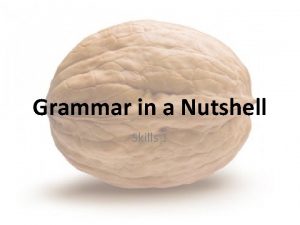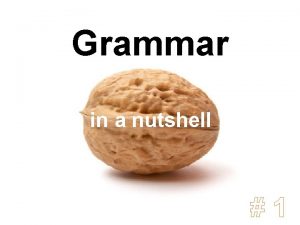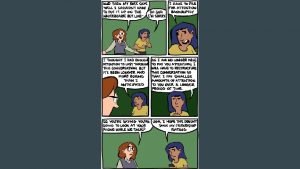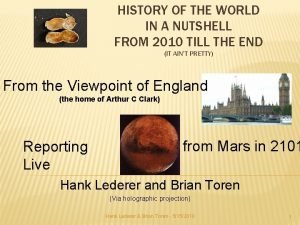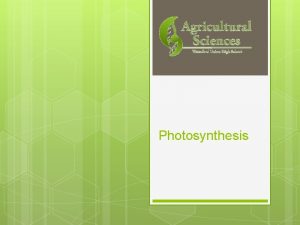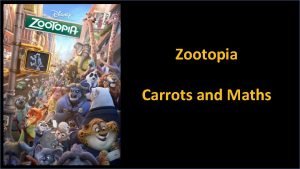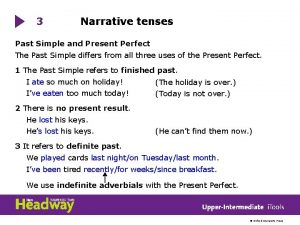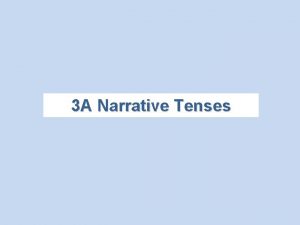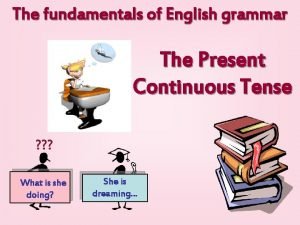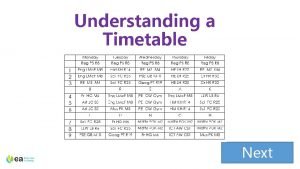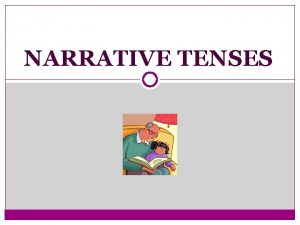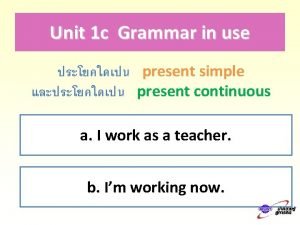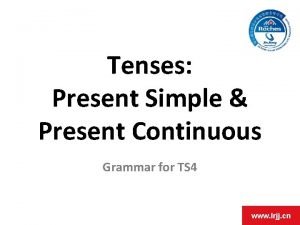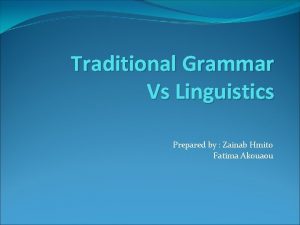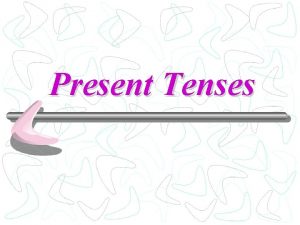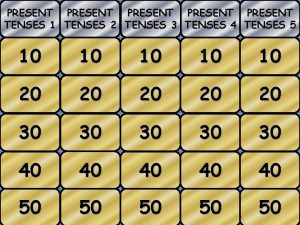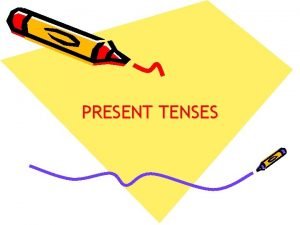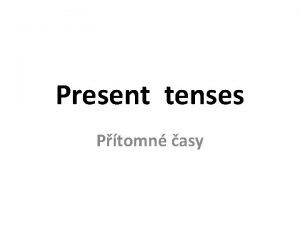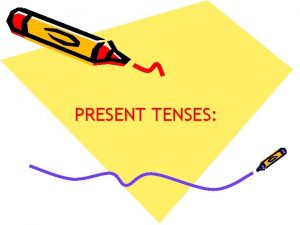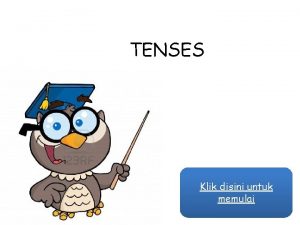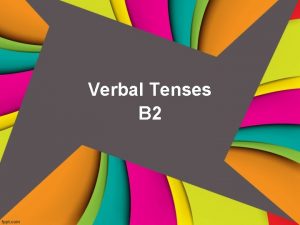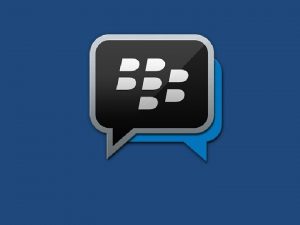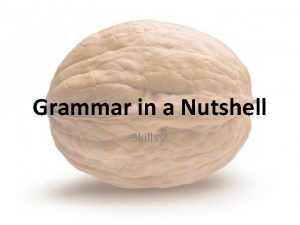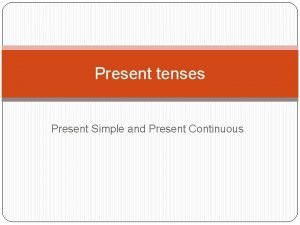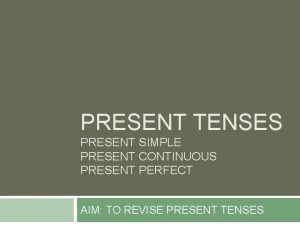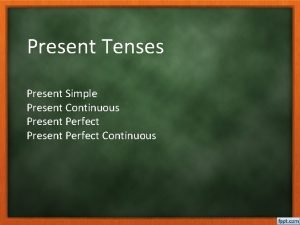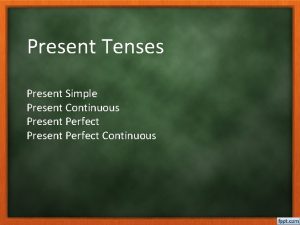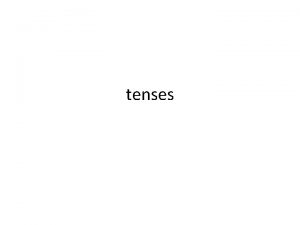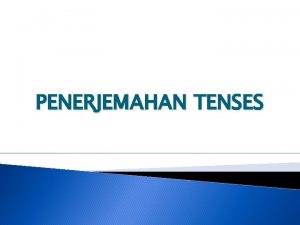Grammar in a Nutshell Skills 1 Present tenses



















- Slides: 19

Grammar in a Nutshell Skills 1

Present tenses • • Present Simple (a. k. a. Simple Present) Present Continuous Present Perfect Continuous Just two grammar exercises in this test: • 1 exercise that combines the present simple and the present continuous • 1 exercise with all the different present tenses

Present Simple When do you use it? Facts: water boils at 100°c. Habits: you study English 3 times per week. Permanent state: I love tea. Describing yourself: He has got brown hair. Check out these signal words: often, usually, sometimes, never…

Present Simple Example: walk Affirmative Negative Interrogative Bevestigend Ontkennend Vragend I walk You walk He walks She walks It walks We walk You walk (plural) They walk I don’t walk You don’t walk He doesn’t walk She doesn’t walk It doesn’t walk We don’t walk You don’t walk They don’t walk Do I walk? Do you walk? Does he walk? Does she walk? Does it walk? Do we walk? Do you walk? Do they walk?

Present Continuous

Present simple – Present continuous Simple Continuous This guy explains the difference: https: //youtu. be/d. Tobo. UPXdx. E

In short: Present Continuous (in Dutch) • Je gebruikt de present continuous om: aan te geven dat iets NU aan de gang is. Signaalwoorden zijn o. a: "now, at the moment, listen. . . " enz. • aan te geven dat je iets van plan bent. Meestal staat er bij wanneer je in de toekomst dat van plan bent. • irritatie aan te geven. Meestal staat het woordje "always" in de zin om het extra duidelijk te maken. • I am reading now. (nu aan de gang) • They are dancing tonight. (vast plan) • He is always teasing me. (irritatie)

Versus: Present Simple (in Dutch) • Je gebruikt de simple present om: aan te geven dat iets een gewoonte is. Signaalwoorden zijn o. a: "always, never, every day" enz. • aan te geven dat iets een feit is. • He always drives fast. (gewoonte) • The sun rises in the east. (feit)

Exercise 1. 2. 3. 4. 5. 6. 7. 8. leaves The train always ________(leave) on time. "What's the matter? Why ________(cry/you)? " are you crying are not watching That's strange. They________(not watch) TV. doesn’t speak He________(not speak) English very well. Please be quiet! I________(do) my homework. am doing Where________(live/they)? do they live is playing Listen! John ________ music! (play) go I never ________(go) to the swimming pool.

Present Perfect Je gebruikt de present perfect om… 1. …te zeggen dat iets in het verleden is gebeurd maar er staat niet bij wanneer dat is gebeurd (als dat er wel staat gebruik je de past simple) 2. …te zeggen dat iets in het verleden is begonnen en nu nog doorgaat (als het is afgerond gebruik je wederom de past simple) Zoals je begrijpt: de present perfect wordt in de toets dan ook in combinatie met de past simple gebruikt.


Present Perfect Hoe ziet dat er uit dan? have / has + voltooid deelwoord I You We They have walked bought listened been 10 miles already. an ugly sweater. to a boring lecture. to France 4 times. She / it (shit) has played tennis since she was young.


Present Perfect Continuous Je gebruikt de present perfect continuous om… …te verwijzen naar een onbepaalde periode tussen ‘nu’ en ergens ‘voor nu’. Je denkt dan over iets dat (al eerder) is begonnen maar misschien nog niet in die periode is afgelopen. Je bent dan geïnteresseerd in het proces als in het resultaat, en dit proces kan nog voortduren of is net afgelopen.


Present Perfect Continuous Hoe ziet dat er uit dan? have / has + been + ww-ing I You We They have She / it has (shit-rule) been walking for 10 minutes already. buying us lots of beers tonight. listening to a boring lecture. going to France for most of my life. been playing tennis since 2 pm.

Present Perfect VS Present Perfect Continuous Watch this video to help you understand the difference: https: //www. youtube. com/watch? v=k. Lxn. RQZrhc 0

Mind! If you talk about ‘ik’ in English, always write ‘I’ with a capital letter. So, no ‘i’ but ‘I’! Please, please, don’t write ‘wanna’ (= want to) or ‘gonna’ (= going to) or something like that. You can say it, but not write it. It is grammatically incorrect. Good luck studying!

Grammar in a Nutshell
 Present perfect present perfect continuous exercises
Present perfect present perfect continuous exercises Grammar in a nutshell
Grammar in a nutshell Web design in a nutshell
Web design in a nutshell Self-attention
Self-attention James webb telescope
James webb telescope Itil in a nutshell
Itil in a nutshell Photosynthesis in a nutshell
Photosynthesis in a nutshell Bfs in a nutshell
Bfs in a nutshell Zootopia rules
Zootopia rules How to write links in apa format
How to write links in apa format English grammar tenses
English grammar tenses Past perfect continuous narrative tenses
Past perfect continuous narrative tenses 3a grammar narrative tenses answers
3a grammar narrative tenses answers What simple tenses are the fundamentals of english grammar
What simple tenses are the fundamentals of english grammar Korean tenses grammar
Korean tenses grammar Tenses when
Tenses when 1c grammar present simple or present continuous
1c grammar present simple or present continuous Present simple present continuous comparison
Present simple present continuous comparison How to convert right linear grammar to left linear grammar
How to convert right linear grammar to left linear grammar Traditional school of linguistics
Traditional school of linguistics
